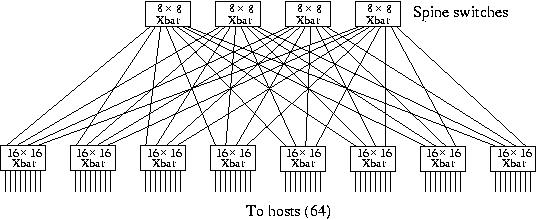
Figure 16. An 8×16 Clos network using 8 an 16 port crossbar switches to connect 64 processors.



Myrinet is the present market leader in fast cluster networks. The Myricom
company which sells Myrinet started in 1994 with its first Myrinet
implementation, [25], as an alternative for
Ethernet to connect the nodes in a cluster. Apart from the higher bandwidth,
around 100 MB/s at that time, the main advantage was that it entirely operated
in user space, thus avoiding Operating System interference and the delays that
come with it. This meant that the latency for small messages was around
10—15 $micro;s. Latency and bandwidth compared nicely with the
proprietary networks of integrated parallel systems of Convex, IBM, and SGI at
the time. Although such a network came at a non-negligible cost, in many cases
it proved a valuable alternative to either an Ethernet connected system or an
even costlier integrated parallel system.
Since then hardware upgrades and software improvements have made Myrinet the
network of choice for many cluster builders and until recently there was hardly
an alternative when a fast, low-latency network was required.
Like Infiniband, Myrinet uses cut-through routing for an efficient utilisation
of the network. Also RDMA is used to write to/read from the remote memory of
other host adaptor cards, called Lanai cards. These cards interface with the
PCI-X bus of the host they are attached to. The latest Myrinet implementation
only uses fibers as signal carriers. This gives a high flexibility in the
connection and much headroom in the speed of signals but the fiber cables and
connectors are rather delicate which can lead to damage when cluster nodes have
to be serviced.
Myrinet offers ready-made 8--256 port switches. The 8 and 16 port switches are
full crossbars. In principle all larger networks are build form these using a
Clos network topology. An example for a 64-port systems is shown in Figure
16

Figure 16. An 8×16 Clos network using 8 an 16 port
crossbar switches to connect 64 processors.
A Clos network is another example of a logarithmic network with the maximum
bisectional bandwidth of the endpoints. Note that 4 ports of the 16×16
crossbar switches are unused but other configurations need either more switches
or connections or both.
Myricom provides benchmark measurements of its networks at
[24] which for the newest Myinet2000
switches give quite good results: about 230 MB/s for a Ping-pong experiment with
latencies around 7 µs for small messages with the MPI version that
Myricom distributes with its networks.


